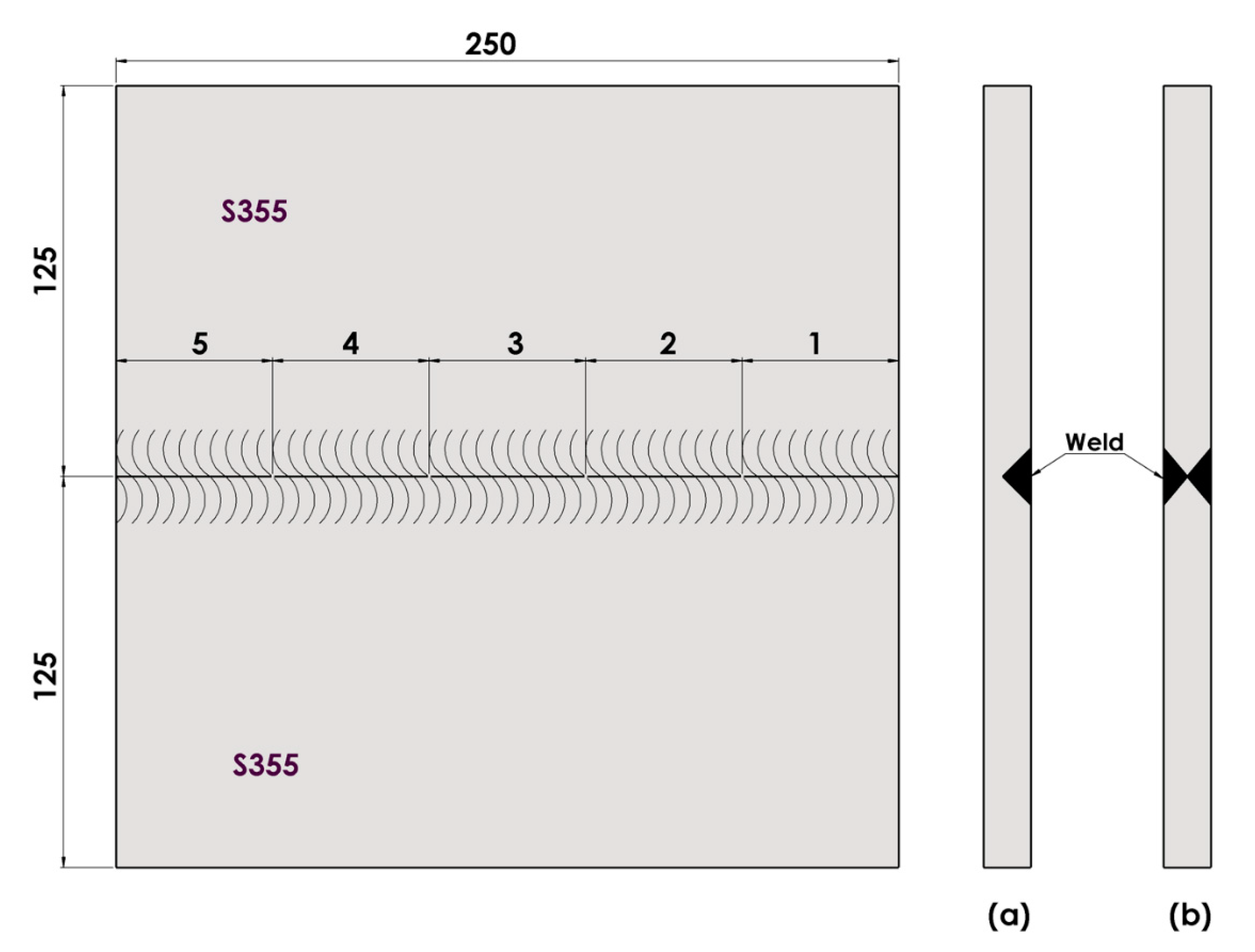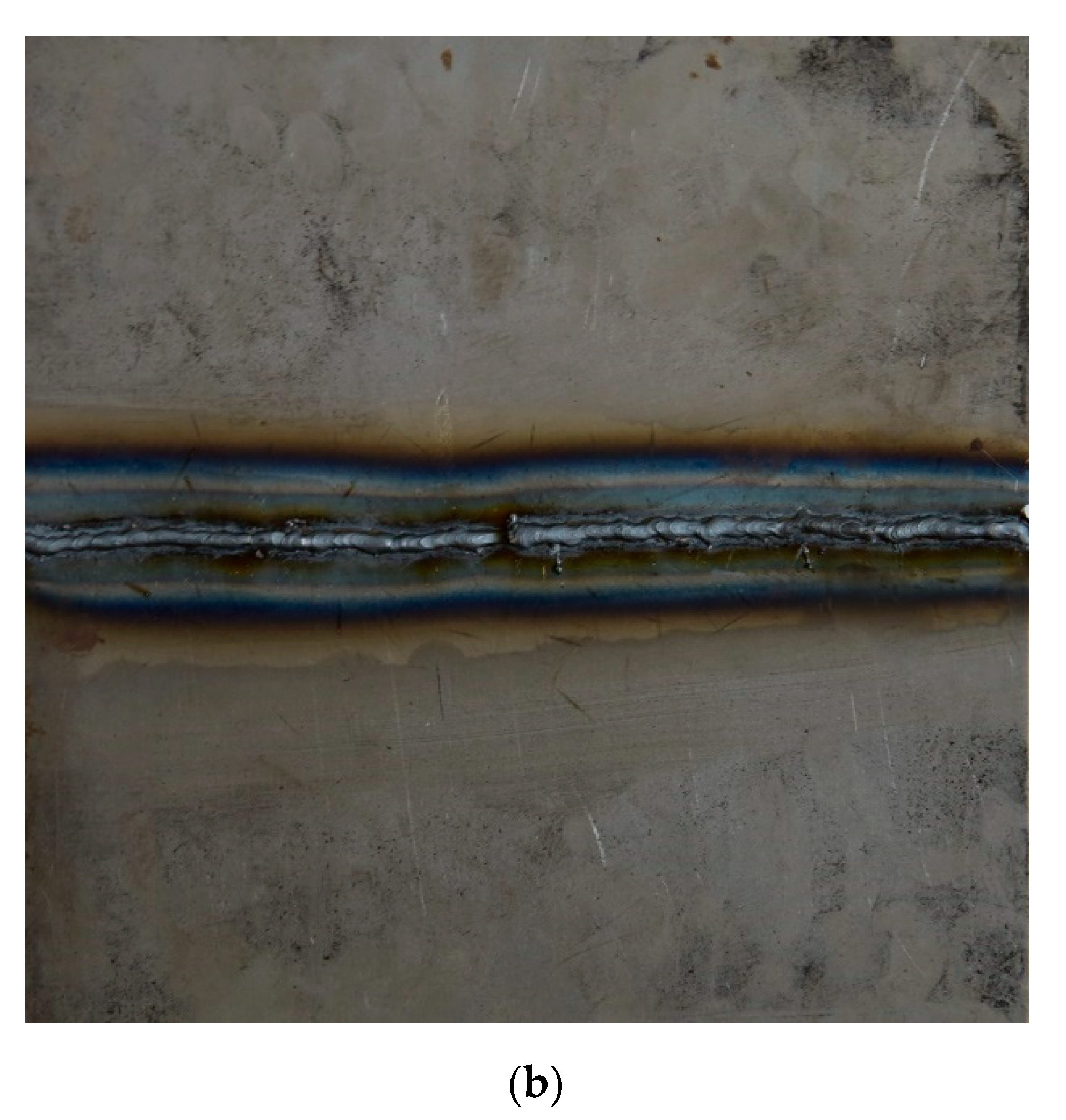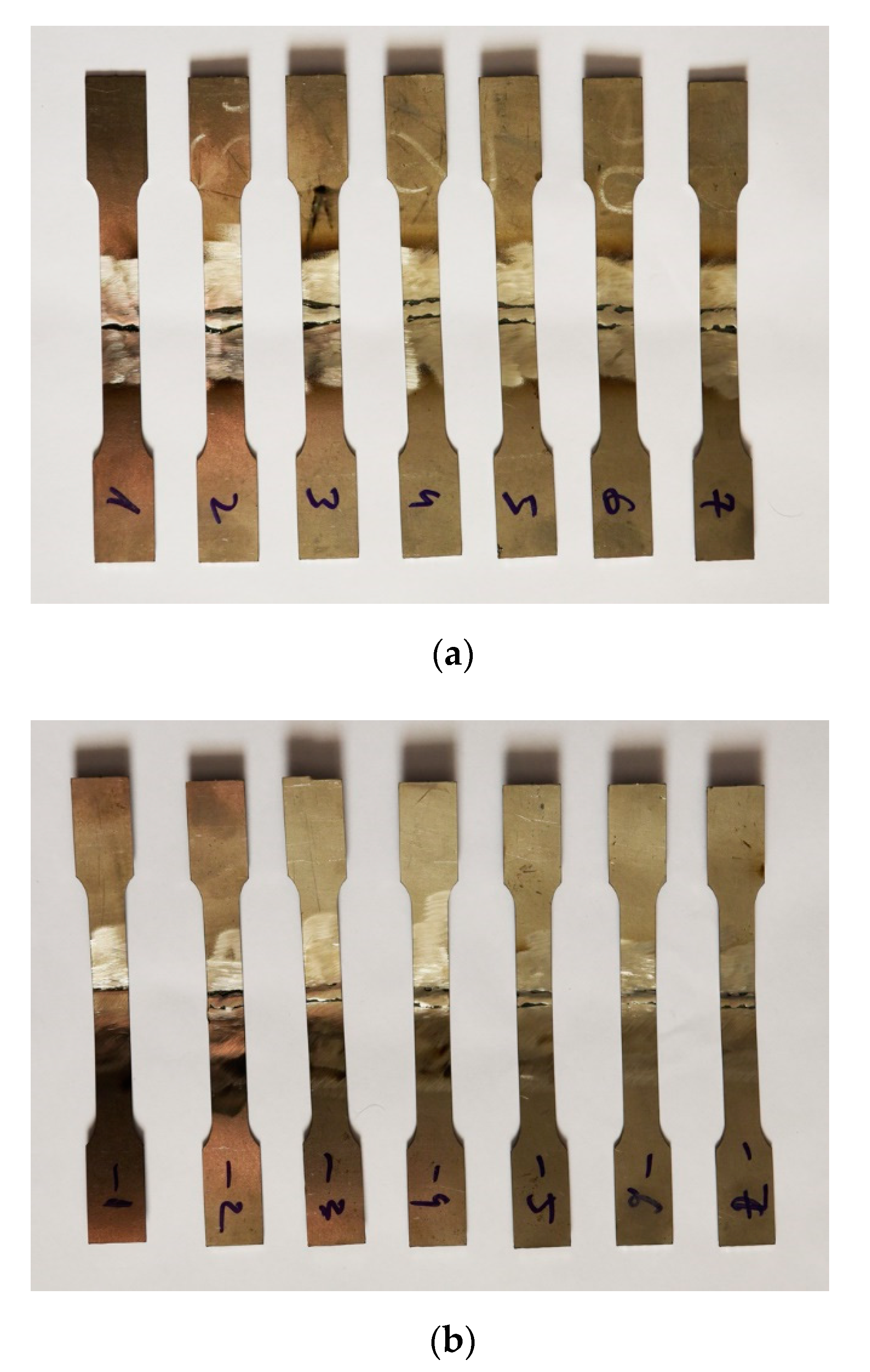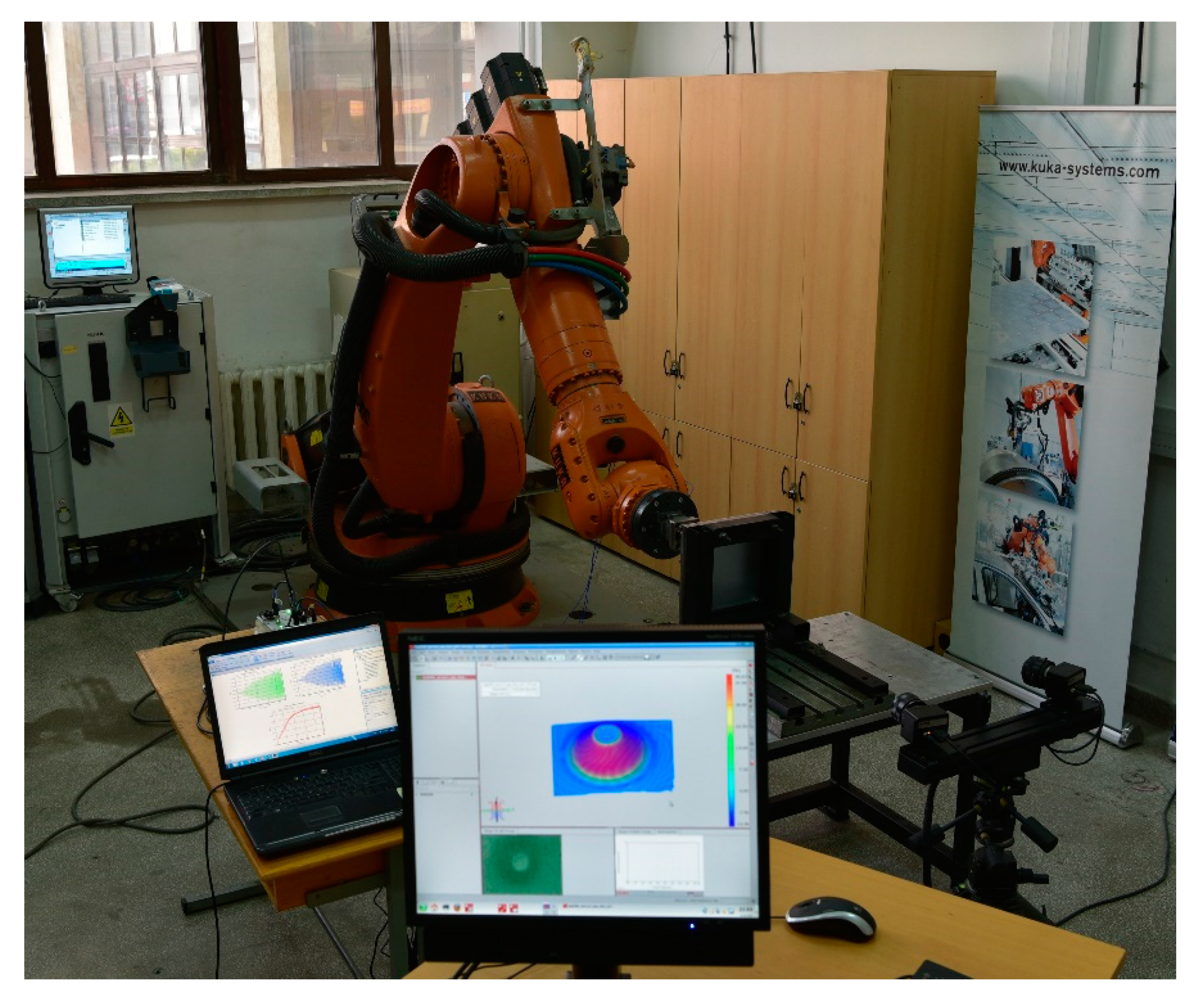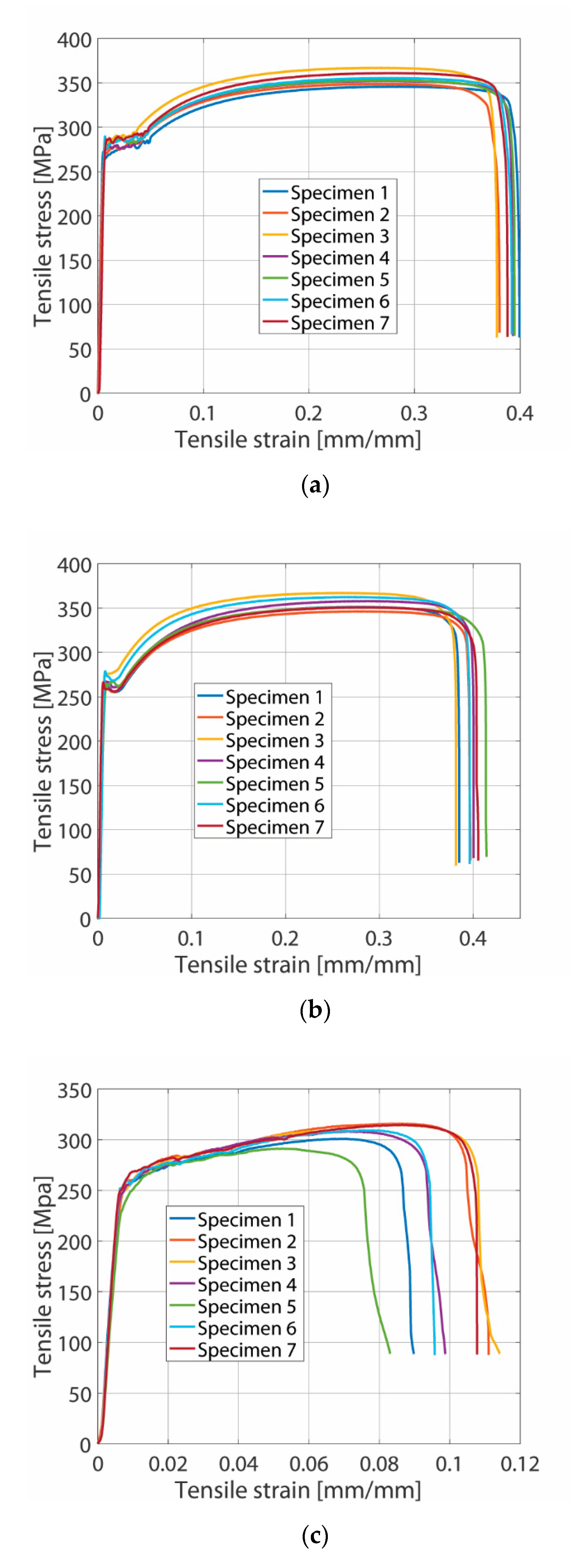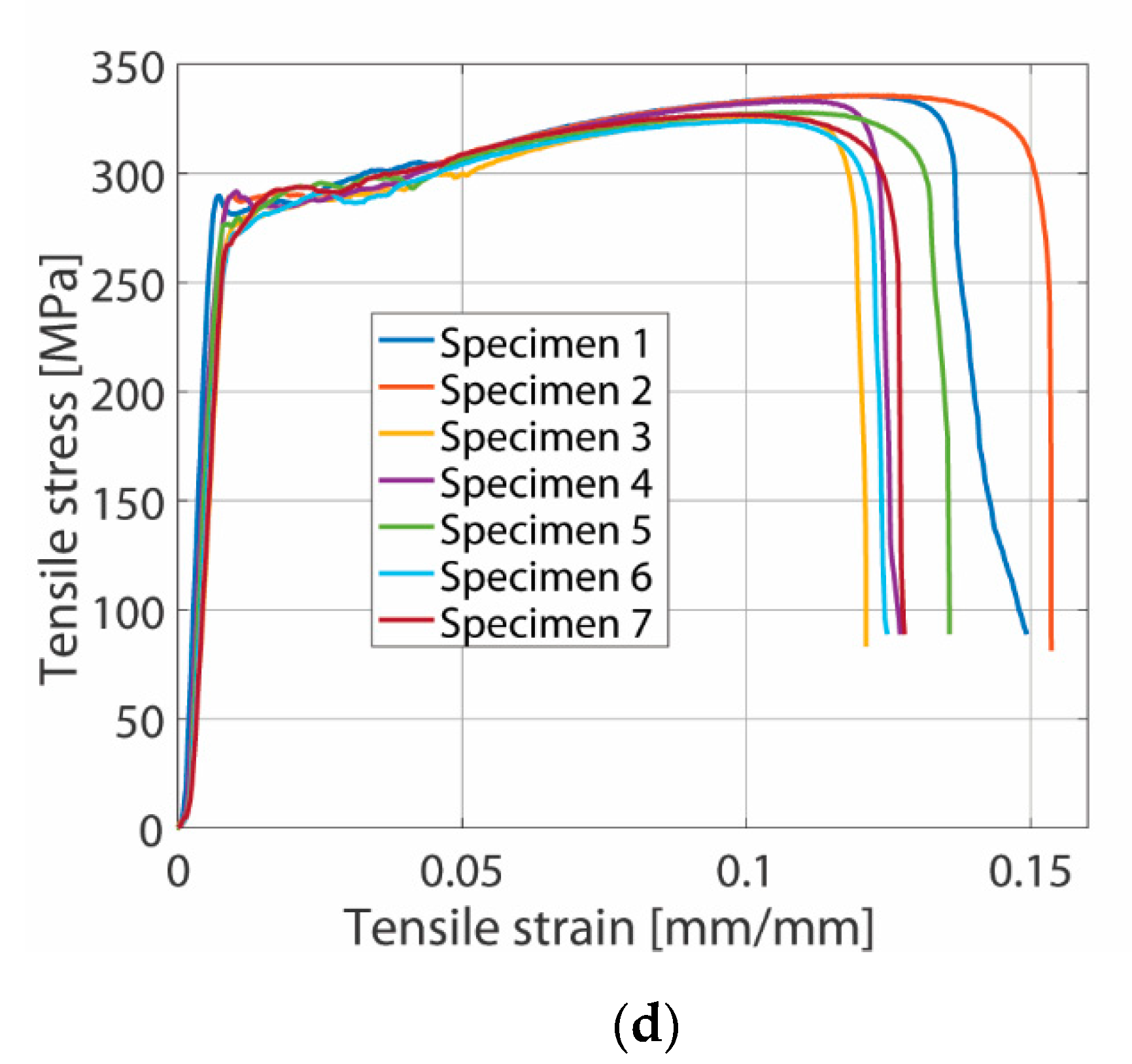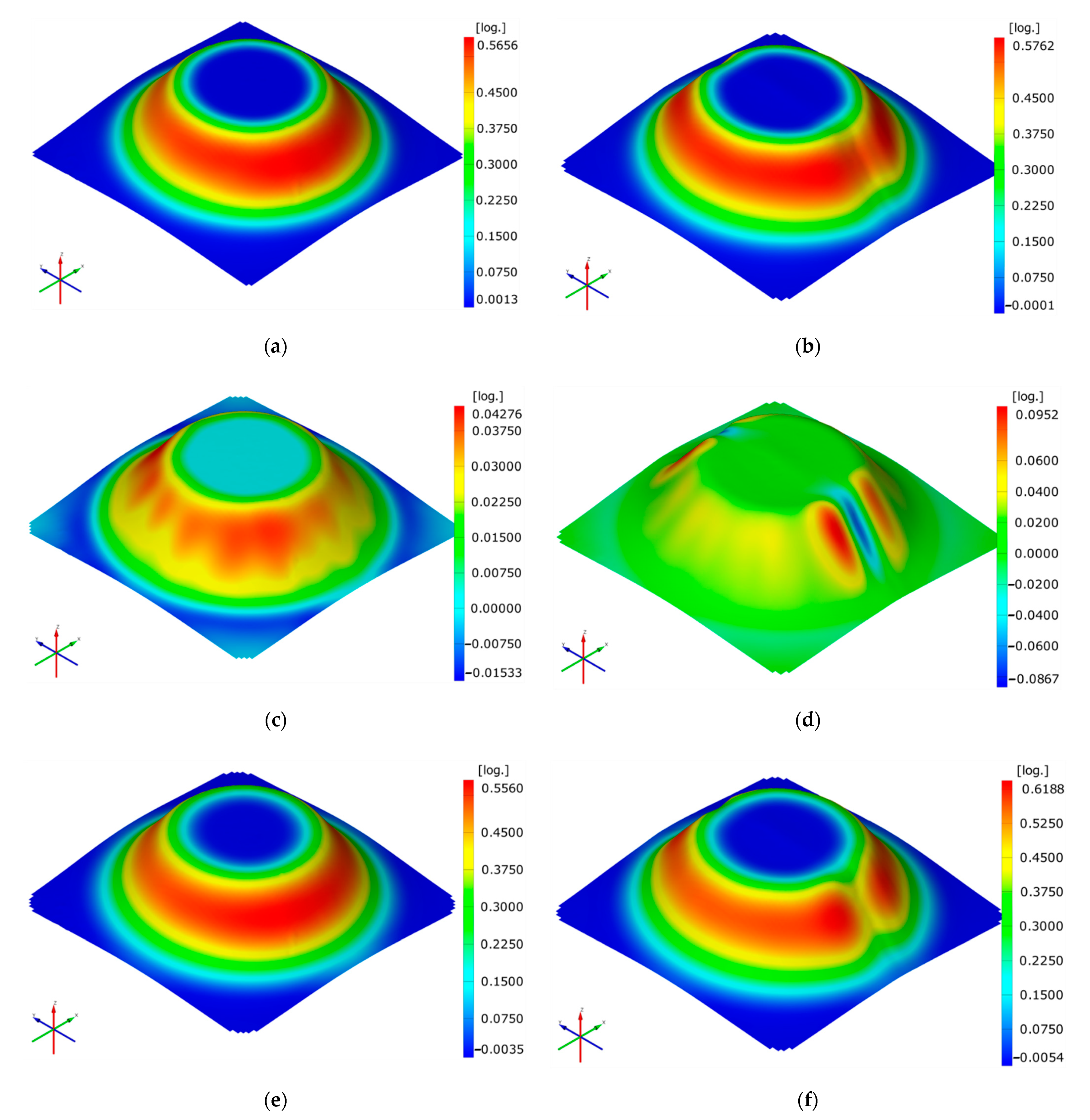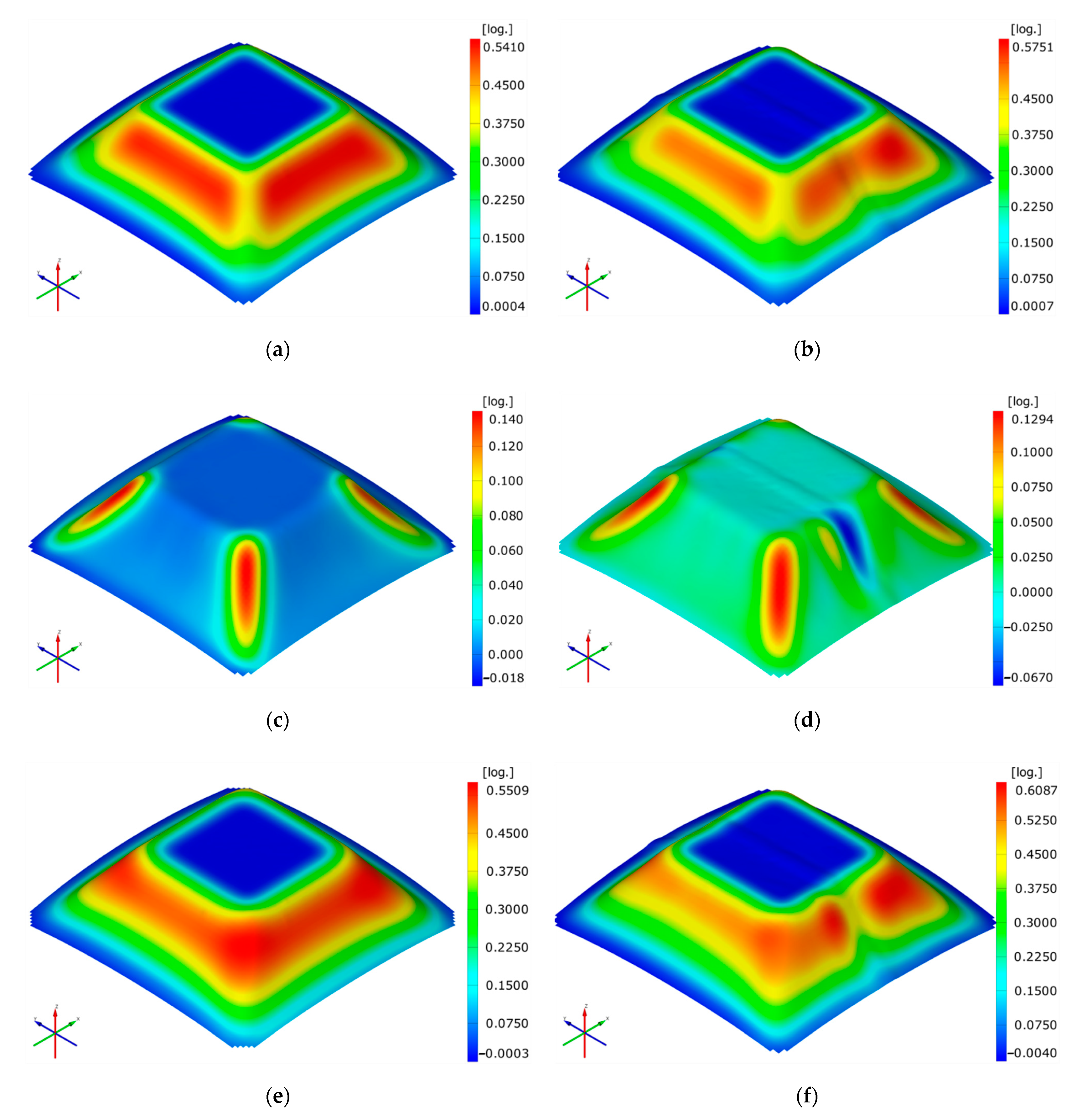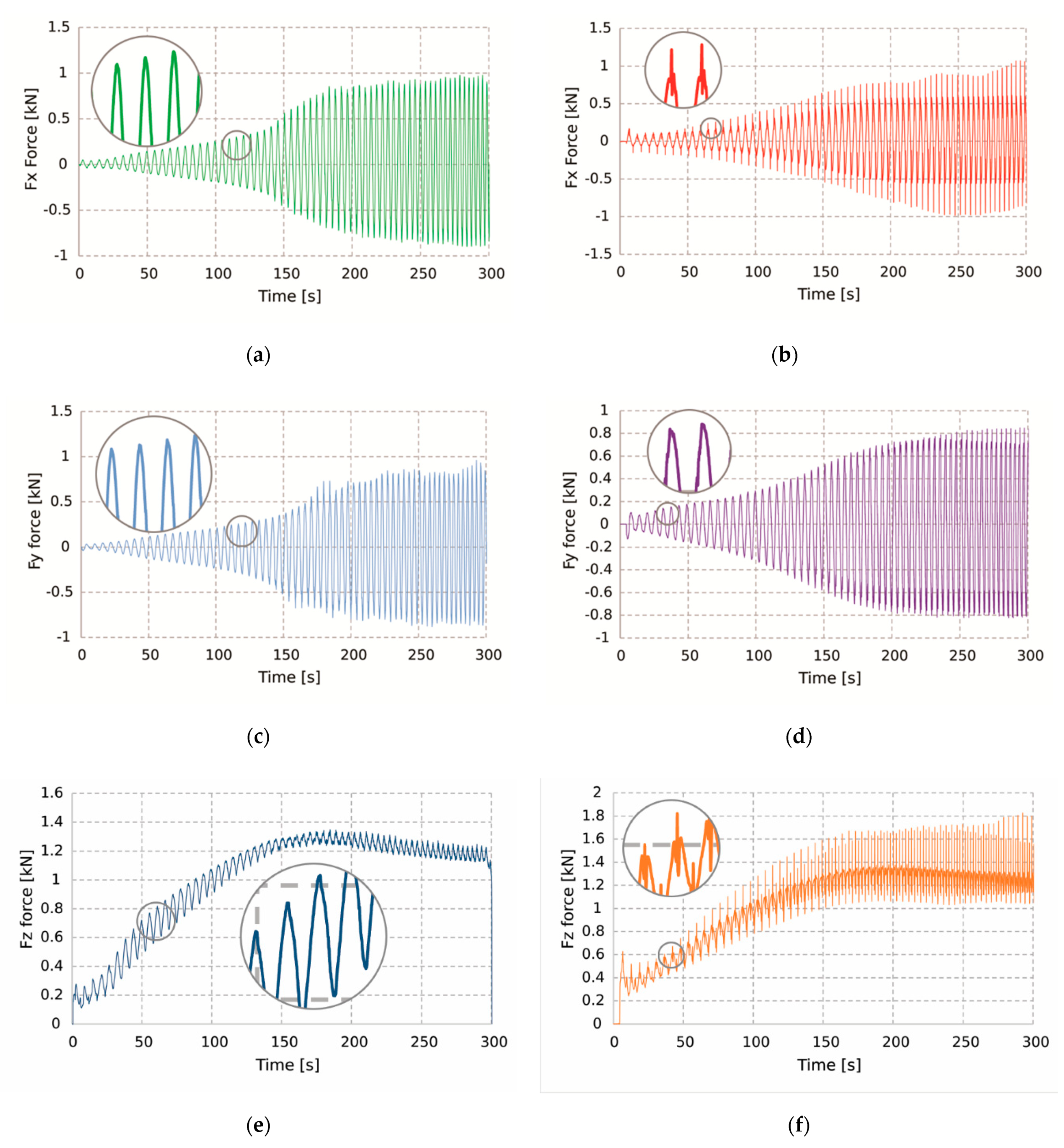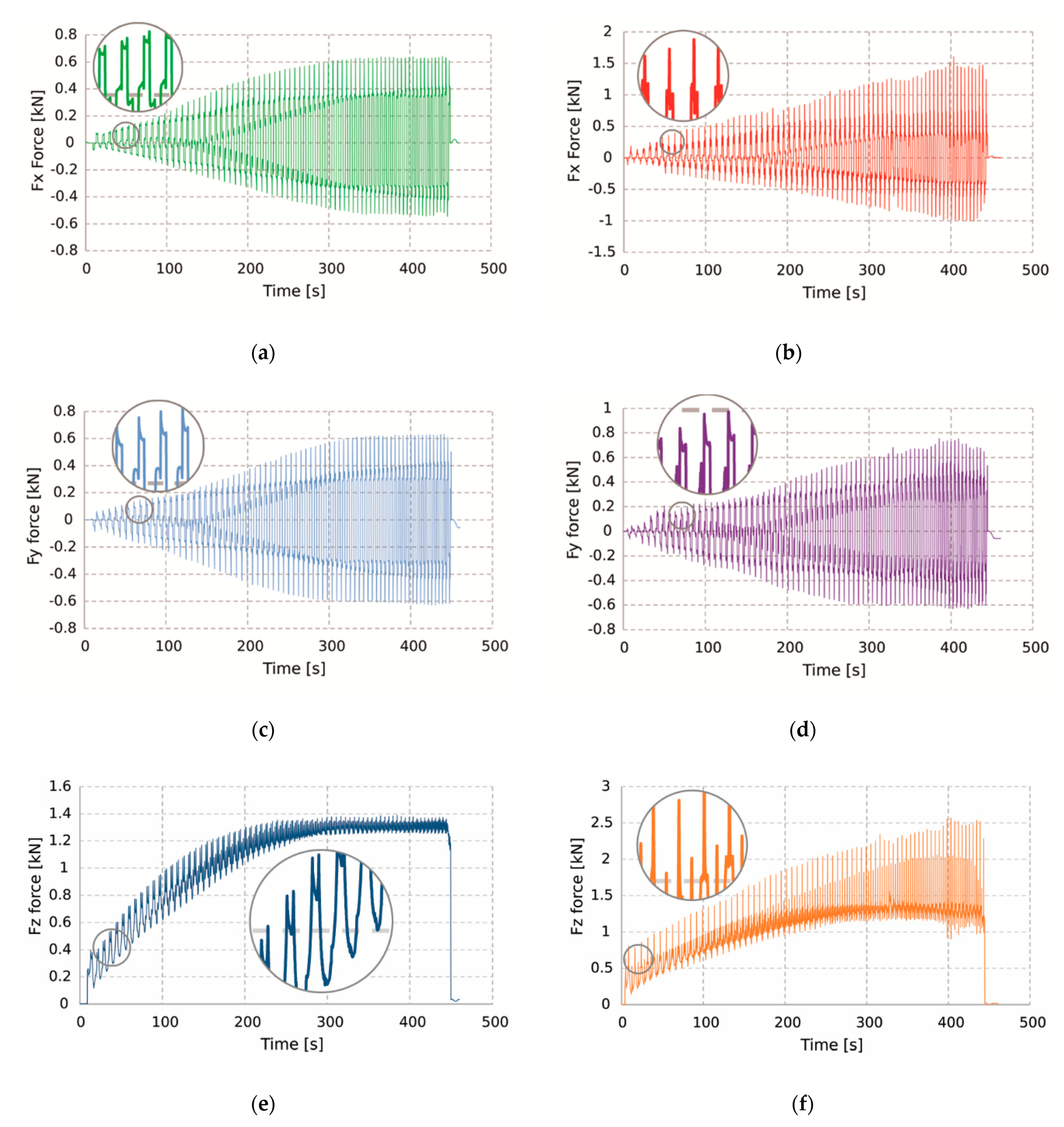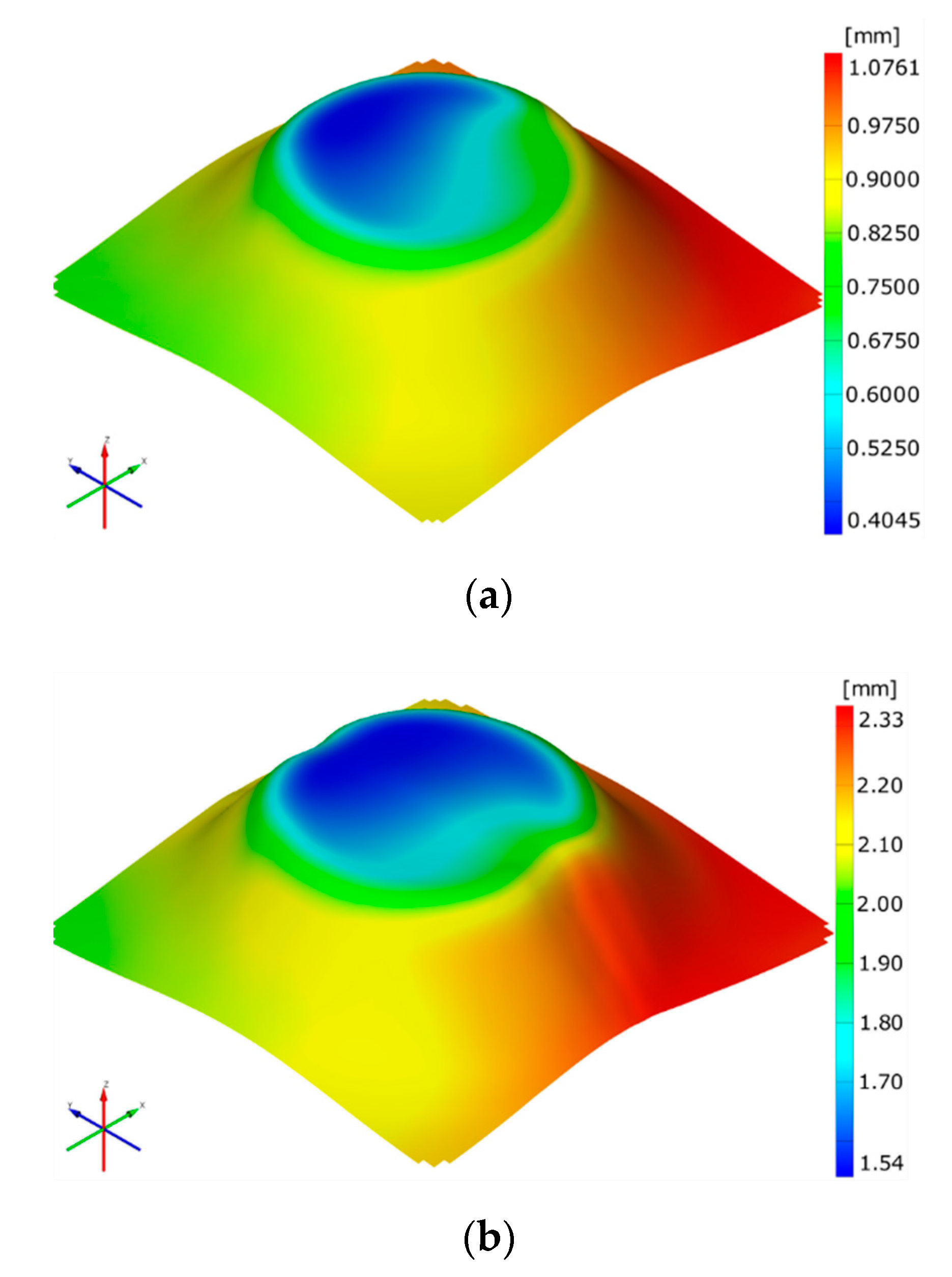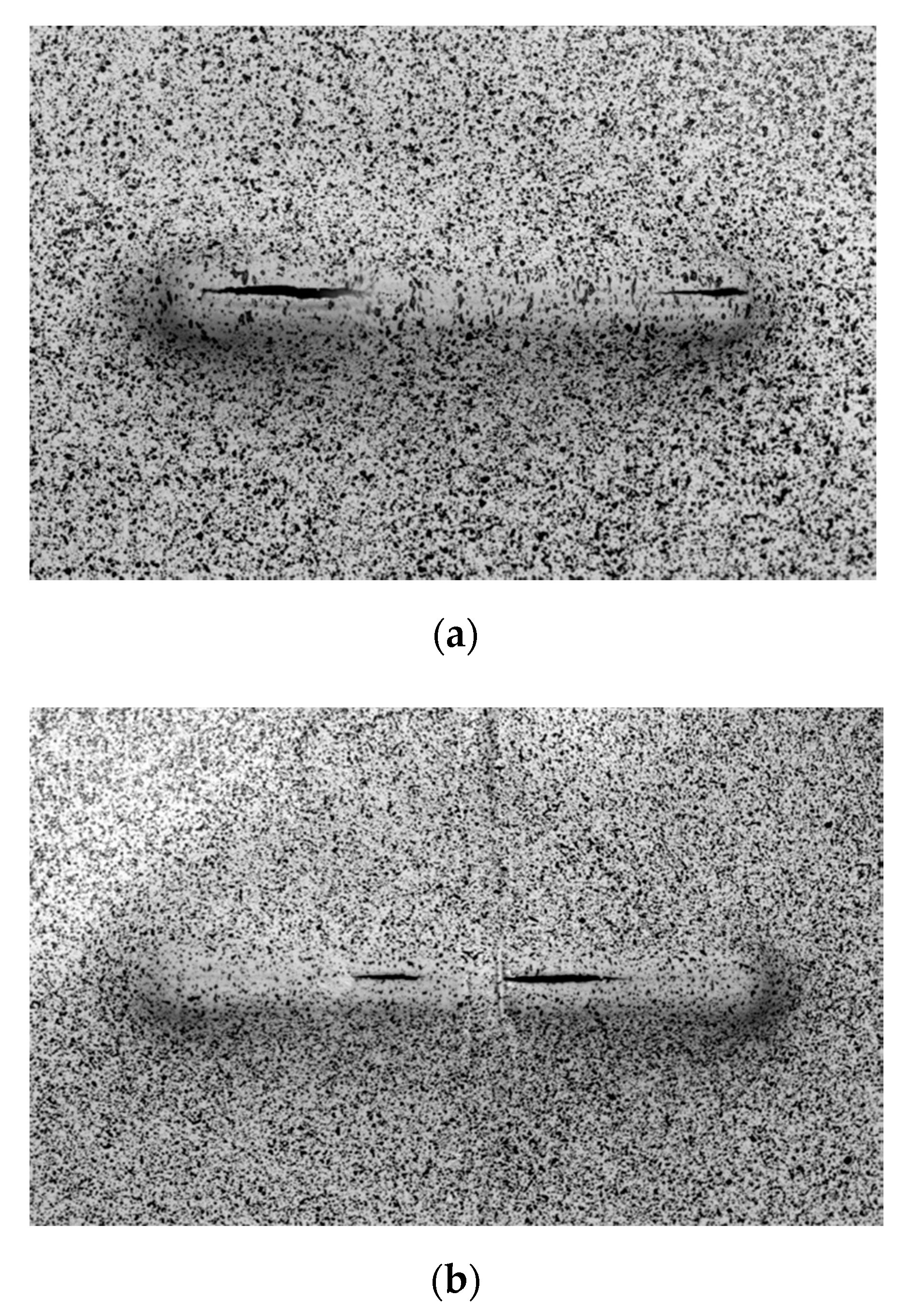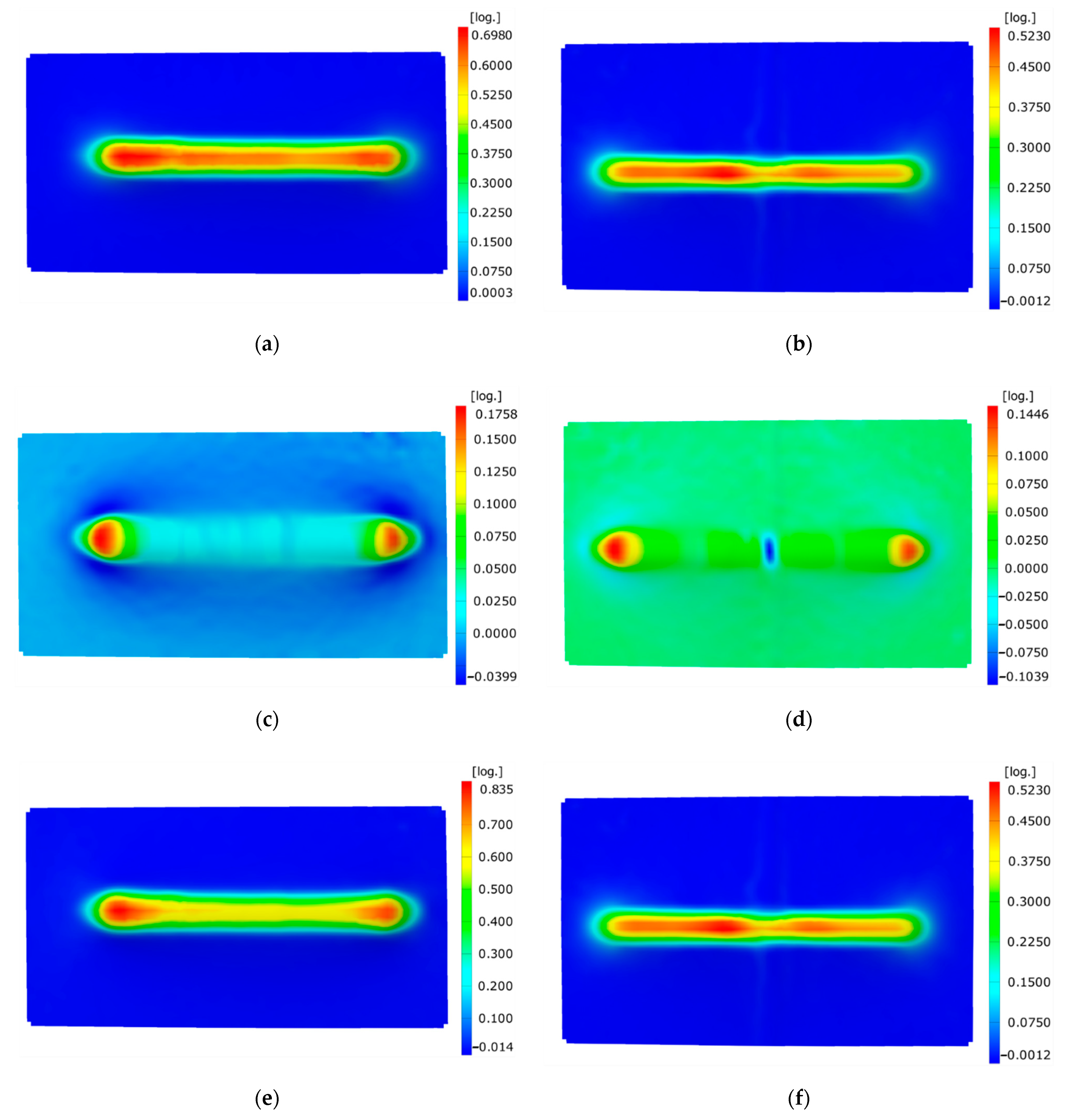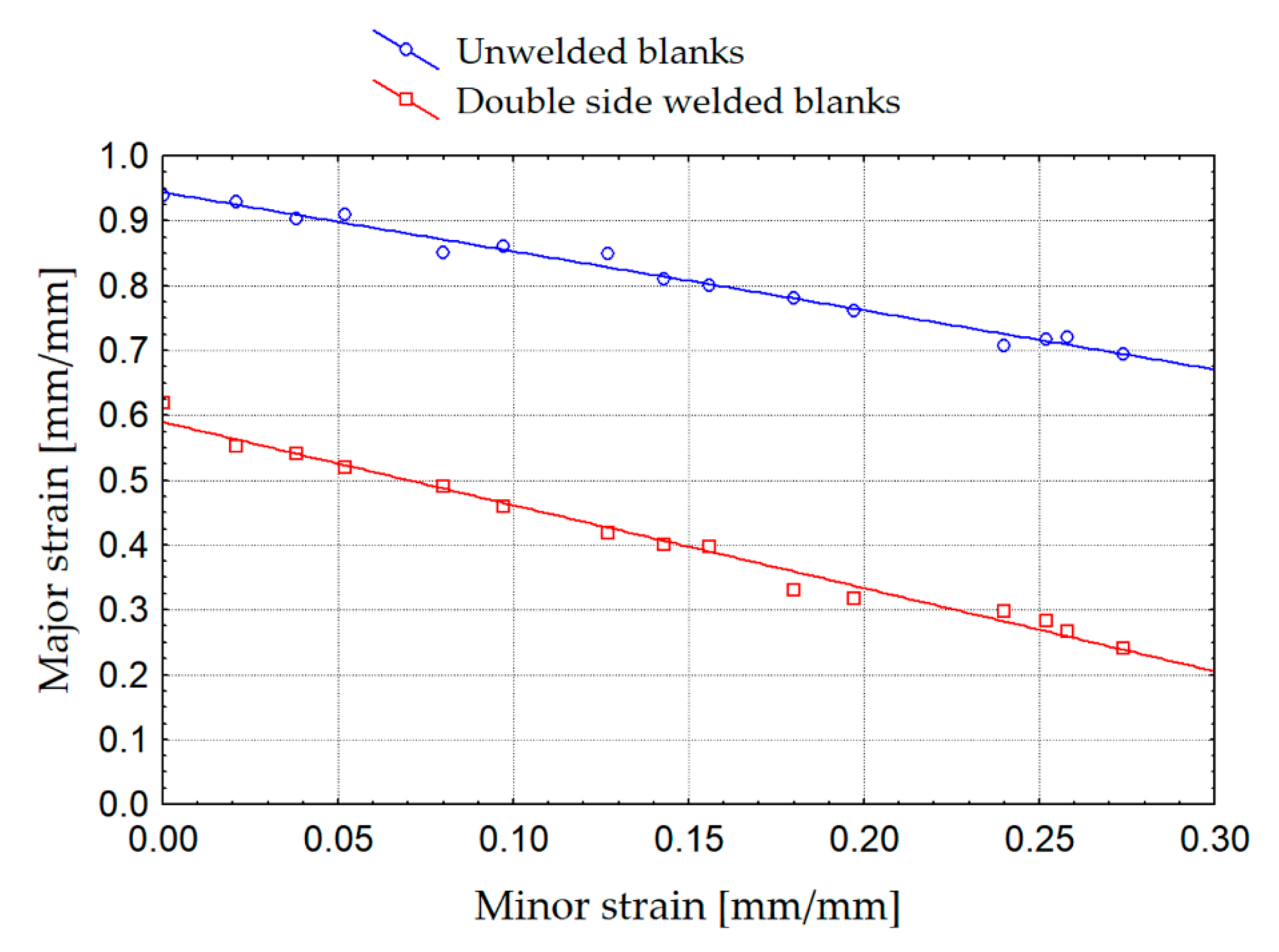3.1. Uniaxial Tensile Test
Sets of seven specimens were made for the unwelded specimens collected for parallel and transverse directions to the rolling direction, for both one side welded specimens and double side welded specimens (both obtained so that the tensile direction coincides with the rolling direction). The results of the experiments are presented in
Table 3,
Table 4,
Table 5 and
Table 6 and in
Figure 5. To highlight the results, the statistical processing is also presented in each table, that is, the mean, standard deviation and
p-value. The Anderson-Darling test, a test derived from the Kolmogorov-Smirnov test, was employed for the purpose of assessing the normality of the data distribution for each type of result. This test is considered to be the most sensitive of all normality tests. If
p ≥ 0.05, the data distribution is considered to respect the null hypothesis, that is, the sample distribution is normal. When analysing the uniaxial tensile test results, it is observed that they all comply with the null hypothesis, most tests producing high (solid)
p-values (greater than 0.4). There is only one exception, that of the tensile strain at break at the double side welded specimens, where the
p-value is 0.175, which is also higher than 0.05.
At the analysis of the one side welded specimens and the double side welded specimens, it is noticed that the break mostly occurs in the thermo mechanical affected zone, in the proximity of the welding bead.
Close values of the measured data are observed from the very start between the unwelded specimens collected for rolling direction and the unwelded specimens collected for transversal direction. It was found that in the case of the unwelded specimens, the mean value of E-modulus is 64,928 MPa for specimens collected for rolling direction and 60,275 MPa for specimens collected for transversal direction, higher than 49,586 MPa for one side welded specimens and 48,555 MPa for double side welded specimens, respectively. These results lead to an increase of the elasticity of the material, the maximum elasticity occurring in the case of the double side welded specimen.
The maximum value of the tensile stress at Yield is obtained in the case of the double side welded specimens, 278 MPa, almost equal to the 276 MPa value, obtained for the unwelded specimens collected for rolling direction. In the case of the maximum tensile stress and tensile strain at maximum tensile stress, close data is observed between the unwelded specimens collected for rolling direction and the unwelded specimens collected for transversal direction (353–355 MPa and 0.2757 mm/mm). As far as the one side welded specimens are concerned, the mean value of the maximum tensile stress is 309 MPa and the tensile strain at maximum tensile stress, which is actually the value of interest, is only 0.0782 mm/mm, that is, only 28.3% of the value obtained for the unwelded specimens. Regarding the double side welded specimens, the mean value of the maximum tensile stress is 330 MPa and the tensile strain at maximum tensile stress is 0.1055 mm/mm, which is 38.3% of the value obtained for the unwelded specimens. The same observations can be drawn regarding the tensile strain at break as well, where the average values for the unwelded specimens ranged between 0.3907 and 0.3970 mm/mm, while in the case of the welded specimens, the values obtained for one side welded specimens and double side welded specimens were 0.1000 mm/mm and 0.1340 mm/mm, respectively. These represent 25.6% of the value of the unwelded specimens collected for rolling direction for one side welded specimens and 34.3% for double side welded specimens, respectively.
When analysing the strain hardening exponent (n) values, it can be observed that it has a higher value in the case of the unwelded specimens, n = 0.22, value which decreases in the case of double side welded specimens and one side welded specimens at n = 0.17 and n = 0.12, respectively. The uniaxial tensile test aimed to set the mechanical properties for unwelded specimens collected on rolling and transversal directions, as well as for one side and double side welded specimens. In fact, the purpose of the uniaxial tensile test was to correlate the mechanical properties with the formability of these materials. When analysing the uniaxial tensile test results, it is observed that both the tensile strain at maximum tensile stress and the tensile strain at break decrease in the case of one side welded and double side welded specimens when compared to unwelded specimens, which leads to a decrease of the formability of these types of sheets. The decrease in the case of one side welded specimens is, of course, more pronounced than that in the case of double side welded specimens. Regarding the Yield stress value, it can be stated that a material with a higher value reaches the plasticity state later, accumulating a higher stress up to the occurrence of the plastic strain. However, the Yield stress value in the double side welded specimens is observed to be approximately equal to that of the unwelded specimens collected in rolling direction. A lower value of the Yield stress, corroborated by a low value of the tensile strain at break, which contributes to the reduction of formability, is found in the one side welded specimen. The analysis of the strain hardening exponent (n) values leads to the observation that both the tensile strain at maximum tensile stress and the tensile strain at break decrease in the case of both one side and double side welded specimens when compared to unwelded specimens. A higher value of the strain hardening exponent (n) leads to a uniform strain distribution and implicitly to a better formability. All these results indicate a significant decrease of the formability of the welded specimens compared to the unwelded specimens. However, in light of the fact that the single point incremental forming is a sheet metal forming process that leads to a significant increase in formability, the experiments were carried on by obtaining the truncated pyramid and truncated cone shaped parts.
3.2. Single Point Incremental Forming of Tailored Welded Blanks
The forming of the truncated pyramid-shaped and truncated cone-shaped parts for the one side welded blanks was firstly attempted. Regardless of the chosen geometry or the pitch of the spiral trajectory, which was used for both trajectories in the case of the first four parts, fractures occurred. They appeared in the immediate proximity of the welded bead, in the heated-affected zone (HAZ) and propagated as it can be observed in
Figure 6. Fractures appeared at different heights of the parts (i.e., at different degrees of deformation), without following a pattern. This fact was also confirmed by the low values of the tensile strain at maximum tensile stress and tensile strain at break obtained for these blanks at the uniaxial tensile test.
It was next proceeded with the obtaining of the parts for the double side welded blanks. Sets of three specimens were made for both the truncated pyramid-shaped and truncated cone-shaped parts. All 12 specimens were conformant, no fractures having occurred. The maximum values of the major strain, minor strain, thickness reduction, as well as of the maximum forces on the three directions of the cartesian coordinate system were first analysed. The obtained results are found in
Figure 7,
Figure 8,
Figure 9 and
Figure 10 and in
Table 7,
Table 8,
Table 9 and
Table 10. In the tables, the first experiment is the one shown in the figure. Also, in the
Supplementary Materials section, we present the movies of the major strain, minor strain and thickness reduction variation over the course of the SPIF process. To assess the normality of the data distribution, the mean value and standard deviation were also calculated and the Anderson-Darling test was applied. The tables indicate that the
p-value is significantly higher than 0.05 for all four types of experiments. The lowest values were obtained for the minor strain in the case of the welded parts, for both the truncated pyramid-shaped and the truncated cone-shaped parts.
As mentioned, the formability of the material in the case of single point incremental forming is improved. This is due to the fact that the plastic deformation takes place locally, incrementally. When studying the principal strain distribution for the unwelded parts, while the plastic strain is observed to have significant values on the part walls, values are almost zero in the flange area and the bottom of the truncated pyramid or truncated cone. In the case of the unwelded truncated cone-shaped parts, it can be observed that in the forming area (on the wall of the truncated cone), the major strain values are much higher compared to those of the minor strain, an aspect which was also observed by Neto et al. [
46]. In fact, an almost uniform distribution of the major strain can be observed on the part wall. Moreover, there is a small negative minor strain in the connection area between the wall and the flanges. This leads to an almost identical distribution of the thickness reduction to that of the major strain. These are highlighted in
Figure 7a,c,e.
In the case of the unwelded truncated pyramid-shaped parts, significant values of the major strain are observed to appear on the wall of the truncated pyramid with maximum values at the end of each linear trajectory, while higher values of the minor strain also appear in the corner areas of the part. The major strain has lower values in the corner areas of the part. Negative values of the minor strain appear at the connection between the wall of the part and the flange, similar to the truncated cone-shaped part. In the case of truncated pyramid-shaped parts, the thickness reduction distribution slightly differs from the major strain distribution, which had lower values in the corner areas. The thickness reduction distribution is almost uniform in this case as well. All these remarks are highlighted in
Figure 8a,c,e.
Regarding the thickness reduction distribution on the part wall, it is known that it respects the sine law.
For the parts produced by single point incremental forming a 55 degree wall angle was used, which corresponds to a logarithmic strain in thickness reduction of 0.556. Testing this angle was chosen for the purpose of evaluating the possibility of increasing the formability compared to the limit condition for a 50 degree wall angle set by Ambrogio et al. [
34]. Analysing the values from
Table 7 and
Table 9, as well as
Figure 7e and
Figure 8e the values obtained for the unwelded blanks are observed to be very close to the analytical value of the logarithmic strain in thickness direction.
It is a well-known fact that there are three main categories of areas in an unwelded part processed by SPIF, namely, flat surfaces, characterized by plane strain stretching conditions, surfaces of revolution, also characterized by plane stretching conditions and intersection areas of the flat surfaces (corners), characterized by biaxial stretching conditions. The analysis of the strain state presented in
Figure 7 and
Figure 8 shows that it changes in welded parts processed by SPIF. On the flat surfaces of the truncated pyramid-shaped parts and on the surfaces of revolution of the truncated cone-shaped parts, the plane strain stretching condition is replaced by a biaxial strain condition in the part wall area. Moreover, if compression strains occur in the welding bead, stretching strains occur on both sides of the welding bead, causing a rapid transition from compression strain conditions to stretching strain conditions. This is explained by the presence in this area of a joint between the base material with a higher plasticity and the weld bead with a low plasticity but higher elasticity. Any discontinuity in a material, along with the welding bead which can be considered a discontinuity, is known to lead to the occurrence of stress concentrators. This contributes to an increased risk of shear and even fractures occurring in this area. No changes were recorded in the corner area of the truncated pyramid-shaped parts, because the welding bead is not found in these areas and does not influence the strain conditions. Regarding the thickness reduction, the maximum value appears, as previously mentioned, in the base material also, in the immediate proximity of the welding bead, as a result of the major strain and minor strain distribution.
The average maximum values of the major strain in the case of the double side welded blanks are ε
1 = 0.58 mm/mm (
Figure 7b and
Figure 8b) for truncated cone-shaped parts and the truncated pyramid, slightly higher than the values obtained for unwelded blanks, ε
1 = 0.55 mm/mm and ε
1 = 0.57 mm/mm, respectively.
The minor strain variation at the double side welded parts differs significantly from that of the unwelded blanks. Thus, in the wall area, positive values of the minor strain appear on both sides of the welding bead, while negative values appear on the welding bead area. These values, when considered as absolute values, are approximately equal, ε
2 = 0.09 mm/mm for the truncated cone-shaped parts and ε
2 = 0.07 mm/mm for the truncated pyramid-shaped parts (
Figure 7d and
Figure 8d). This change in the minor strain values in the heat affected zone leads to the danger of fractures occurring in this area. Practically, when comparing the maximum values of the minor strain, the values observed in the case of double side welded truncated pyramid-shaped parts (ε
2 = 0.13 mm/mm) are lower than those of the unwelded parts (ε
2 = 0.14 mm/mm), both maximum values appearing in the corner areas of the part. On the other hand, in the case of the truncated cone-shaped parts, due to the presence of the welding bead, the maximum values of the minor strain are ε
2 = 0.1 mm/mm for the double side welded blanks and ε
2 = 0.04 mm/mm for the unwelded blanks.
As far as the thickness reduction is concerned, the distribution for both types of trajectories is similar to the major strain distribution. It is observed that the maximum values of the thickness reduction appear at both types of trajectories in the part wall area, in the heat affected zone, on the left and right sides of the welding bead, symmetrically arranged. The average maximum values of the thickness reduction in the case of double side welded blanks are εt = 0.61 mm/mm for the truncated pyramid-shaped parts and εt = 0.62 mm/mm for the truncated cone-shaped parts, higher than εt = 0.55 mm/mm for both categories of unwelded blanks.
The decrease of the major strain and thickness reduction values in the welding bead and implicitly the obtaining of maximum values in the thermo mechanical affected areas was also observed by Rattanachan et al. [
43] for parts obtained by FSTW.
The graphs showing the force variation during SPIF of the double side welded blanks maintain, as can be seen in
Figure 9 and
Figure 10, the force variation tendency of the unwelded blanks. At both types of trajectories, the forces increase from zero at the beginning of the process, to the maximum value towards the end of the process, with variations in between, depending on the punch position at a given moment. If the force on the z direction has positive values only, the forces on the x and y directions oscillate around zero. The values and variation behaviour of the forces in the unwelded blanks processed by SPIF are in complete agreement with other studies [
33]. It should be noted from the very beginning that the forces in the processing of the truncated pyramid-shaped parts were higher due to a lower value in the z direction of the spiral trajectory pitch. The paper presents (
Figure 9 and
Figure 10) the unfiltered force variation on the x, y and z directions. This approach was chosen with the purpose of highlighting the changes that occur in the force variations of the unwelded specimens and welded specimens. Thus, the mentioned differences can be observed in the detailed image of each figure. Local maxima (peaks), which appear at the passing of the punch over the welding beads, can be observed at both the truncated pyramid trajectory and the truncated cone trajectory. These local maxima are present at the forces on the z direction, as well as at the forces on the x direction (in the case of force measurement), perpendicular to the welding bead. The presence of these peaks is due to the fact that the welding bead has a higher strength than that of the base material. The local maxima are not present on the y direction, as this direction is parallel to the welding bead. This is more pronounced in the case of the truncated pyramid-shaped parts, as a consequence of the trajectory that alternately coincides with the two directions of the axes. This difference is faded at the truncated cone-shaped parts.
At both types of trajectories, the maximum value appears in the z direction, the direction of the punch penetration. In the case of the truncated pyramid-shaped parts, the maximum average value of the Fz force was Fz = 1.39 kN for unwelded blanks and Fz = 2.39 kN for double side welded blanks, while in the case of the truncated cone-shaped parts, the values obtained were Fz = 1.26 kN for unwelded blanks and Fz = 1.85 kN for double side welded blanks, respectively.
The parts obtained from unwelded blanks had approximately equal maximum values of the forces in the x and y directions: Fx = Fy = 0.63 kN for the truncated pyramid-shaped parts and Fx = Fy = 0.90 kN for the truncated cone-shaped parts. In the case of the parts obtained from double side welded blanks, the values were Fx = 1.39 kN and Fy = 0.70 kN for the truncated pyramid-shaped parts and Fx = 1.11 kN and Fx = 0.91 kN for the truncated cone-shaped parts. In both situations an increase of the value of the Fx and Fy components is observed in the parts obtained from double side welded blanks.
The forces at the parts formed by SPIF obtained in the case of double side welded blanks are higher than those obtained in the case of unwelded blanks, due to the punch passing over the welding bead. The Fz force in SPIF for welded blanks is 72% higher than for unwelded blanks in the case of truncated pyramid-shaped parts and 49% higher in the case of truncated cone-shaped parts. The Fx force in SPIF for welded blanks is 120% higher than for unwelded blanks in the case of truncated pyramid-shaped parts and 22% higher in the case of truncated cone-shaped parts.
In the case of metal forming processes in general and of the incremental forming process (SPIF) in particular, knowing the springback value is especially important, because it influences the accuracy of the part. Knowing the springback value allows the correction of the punch trajectories, so as to eliminate dimensional and shape errors. Following the completion of the forming process, the punch was retreated from the part, 8 of the total 12 screws were removed, the part only being supported by the 4 remaining screws, situated in the bottom part of the experimental layout. After these steps, the springback values were measured.
Figure 11 shows the total displacement variation for the truncated cone-shaped parts. The springback values for the four categories of parts are presented in
Table 7,
Table 8,
Table 9 and
Table 10. The springback has a higher value in the case of welded sheets. This is due to the fact that the unwelded sheets in the SPIF process have a relatively uniform stress distribution, which leads to a lower springback value in the welded sheets, whereas the presence of the welded bead produces a non-uniform stress distribution and implicitly higher springback values. This is also correlated with the uniaxial tensile test results, where it can be observed that the welded sheet has lower values of the E modulus, that is, a higher elasticity and consequently, higher springback values.
When analysing the images that show the springback value, it can be observed that in both the cases of welded and unwelded parts, it is not uniform on the entire surface of the part. The maximum value of the springback appears in the area of the last contact between the punch and the blank, for both the truncated pyramid and truncated cone-shaped parts. However, as can be seen in
Figure 11, the maximum springback values appear in the flange area. The maximum values obtained in the bottom area were therefore analysed for comparison, since this is the area of interest following the forming process. In both cases, the springback is higher for the welded parts than for the unwelded parts. This is due to the presence of the welding bead, which has a higher elasticity than that of the base material. The maximum values in the case of the truncated pyramid-shaped parts are s = 0.969 mm for the parts obtained from unwelded blanks and s = 2.24 mm for the ones obtained from double side welded blanks. As for the truncated cone-shaped parts, the maximum average values are s = 0.443 mm and s = 1.563 mm for the parts obtained from unwelded blanks and double side welded blanks, respectively.
Marathe also concluded, on the basis of a finite element simulation, that the maximum springback value occurs in the case of TWBs compared to unwelded blanks, especially in the case of strong materials [
41].
With the focus on determining the formability in SPIF, the uniaxial tool path test (uniaxial stretching test) is used, that is, a test in which the punch executes a linear trajectory, with penetrations in the material only at the ends of this trajectory, until the first fracture occurs. Only double side welded blanks were tested, without testing one side welded blanks also, because these blanks could not be formed by SPIF without cracks.
Figure 12 presents the specimens immediately after the crack occurred.
The performing of a bi-axial stretching test (cross test) was also intended but this was not possible due to the presence of the welding bead on the exact direction of the punch movement, which would have significantly influenced the results. In this type of test, it is known that in the case of unwelded blanks, a pure uniaxial stretching is generated on the linear trajectory and a bi-axial stretching is generated at the ends of the trajectory (that is, the major strain has significant values along the linear trajectory and the minor strain increases at the ends of the trajectory). This is also visible in
Figure 13.
The analysis of the images in
Figure 13 shows that, while in the case of unwelded blanks the fracture appears and develops from the ends of the trajectory towards its middle, as it is normal, in the case of double side welded blanks the fracture appears and develops in the heat-affected zone and is heading towards the ends of the trajectory. All values in
Table 11 and
Table 12 were extracted from the images acquisitioned immediately before the fracture occurred.
The material is observed to not suffer a major thickness reduction in the welding bead but in its immediate proximity, in the heat-affected zone. The maximum thickness reduction value for the welded blanks is εt = 0.55 mm/mm, compared to εt = 0.84 mm/mm in the case of unwelded blanks. The maximum value of the major strain for the welded blanks is ε1 = 0.52 mm/mm, compared to ε1 = 0.70 mm/mm in the case of unwelded blanks, while the maximum value of the minor strain for the welded blanks is ε1 = 0.15 mm/mm, compared to ε1 = 0.18 mm/mm in the case of unwelded blanks. However, a conclusion similar to that of the analysis of the minor strain variation at the welded blanks formed by SPIF can also be drawn in the analysis of the minor strain distribution at the uniaxial stretching test. In exact terms, a ε2 = −0.10 mm/mm negative value of the minor strain is observed, which leads to the occurrence of the fracture in the heat-affected zone. A maximum height reduction is also observed, from h = 14.37 mm in the case of unwelded blanks to h = 12.3 mm in the case of welded blanks.
Taking into account the results obtained for the truncated cone-shaped parts and the truncated pyramid-shaped parts produced at 60 degrees for double side TWBs (where fractures appeared in the thermo-mechanical affected zone), parts at 65 degrees were also produced for unwelded blanks until the break occurred. Corroborated by the results obtained in the previously presented uniaxial stretching test, the flow limit curves (FLC) for these materials were plotted. It is known that due to the localization (local action) of the plastic strain and the nature of the SPIF process, the formability of materials processed by SPIF is higher than that in the case of other sheet metal forming processes, such as deep-drawing. The FLC curve, plotted in major strain—minor strain coordinates, is graphically represented by a line with negative slope. The vast majority of the pairs of points (major strain—minor strain) on the FLC are located near the major strain, validating the idea of there being a plane strain state. However, a decrease of formability is observed in the TWB sheet, due to the appearance of the maximum values of the major strain and thickness reduction in the immediate proximity of the welding bead.
When analysing the graph in
Figure 14, it can be seen that the FLC for the double side TWBs produced by MAG is positioned lower on the ε
1-ε
2 diagram, which indicates an approximate 30% reduction of the formability compared to the unwelded blanks.
In addition, the line that defines the FLC for TWBs has a higher slope (in module) than that of the unwelded blanks. The decrease of formability in SPIF of TWBs compared to unwelded blanks was also observed by Rubino et al. for TIG welded sheets processed by SPIF [
42]. They observed a remarkably lower formability of TWBs produced by TIG than that of unwelded blanks or FSTW blanks.
